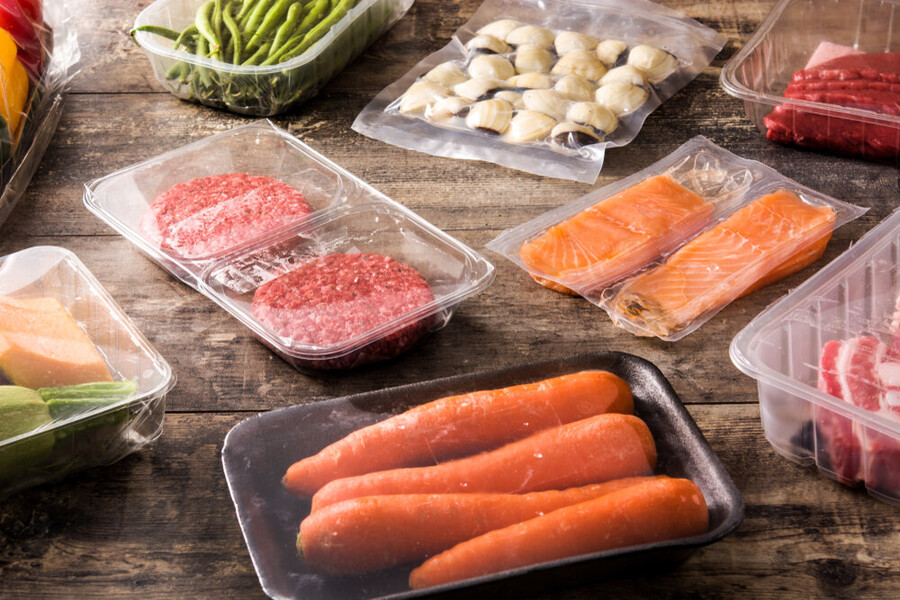The world is working on ending plastic pollution through a new plastics treaty. If the treaty gets the science right, it has enormous potential to detoxify the planet. But right now, this goal is far beyond reach because there is an elephant in the room: plastic chemicals.
The issue of plastic chemicals is not sufficiently being addressed. Instead, almost all efforts are focused on getting rid of plastic waste in the environment with end-of-pipe solutions, while completely disregarding the fact that all commodity plastics leach known hazardous chemicals into foodstuffs that are eaten by people on a daily basis.
To ensure safety of people and the planet, hazardous chemicals in plastic food packaging must be properly addressed, using modern science.
Why do hazardous chemicals in food packaging matter?
Plastics and other food contact materials (FCMs) can contain known hazardous chemicals which can transfer into foodstuffs under certain conditions of normal use — a process known as “migration.”
This chemical migration has been recognized for over 50 years and is addressed by regulations (for example, the FDA’s amendment of 1959). But what is becoming increasingly clear is that those regulations do not sufficiently protect human health from the detrimental effects of some hazardous chemicals that migrate from FCMs.
"CHE Science Snippet" Webinar Preview
Indeed, in October 2022 the US Government Accountability Office reviewed FDA’s approach to FCM safety and stated that “Some of these [migrating] substances may pose health risks.”
Chemicals can cause chronic diseases
People are not exposed to hazardous chemicals solely from FCMs. From superfund sites to body lotion and holiday sweaters, chemicals of concern are lurking in many parts of everyday life. But they become even more personal when they are in foodstuff because they are ingested and may be taken up in the gastrointestinal tract.
It is well known that chemicals can contribute to the increasingly prevalent chronic diseases that society across the globe is battling with, from obesity to infertility, from neurological disorders to weakened immune system, and from cardiovascular disease to cancers.
Chemical exposures are not the only cause, but they play a role and, importantly, they can be avoided.
A new approach is needed
In September 2023, an international team of over 20 scientists shared a new vision to work toward a world where FCMs are free from hazardous and untested chemicals. The group identified key gaps in risk assessments that hinder sufficient protection of human health and the environment, including that:
- Assessments focus on one chemical at a time, particularly cancer-causing chemicals that are genotoxic.
- Current safety evaluations focus primarily on substances used in the manufacturing of food contact articles, overlooking compounds that emerge during production – the so-called non-intentionally added substances (NIAS) which can make up the bulk of migrating chemicals for some FCMs (like can coatings). In most cases, NIAS are unknown chemicals.
The scientists suggest testing the whole cocktail of chemicals that migrate from the final food contact article, including unknown NIAS, and broadening toxicological evaluations to cover a variety of diseases.
This is supported by recent research from the PlastChem project identifying over 16,000 known plastic chemicals, with less than 6% currently subject to global regulation. Sixty-six percent of these plastic chemicals do not have any data on their hazards. Moreover, it is assumed that many more unknown chemicals are widespread in all plastics as NIAS.
The devil in the molecular effects
As part of the research, the six clusters of disease (SCOD) concept was developed. It shifts the focus beyond cancer as the sole and most concerning chronic disease for testing chemical hazards and includes additional prevalent and increasingly concerning non-communicable diseases linked to chemical exposures: cardiovascular, reproductive, brain-related, immunological, and metabolic disorders, in addition to cancers.
For some of these associations, mechanistic evidence helps us understand the modes of action – how these chemicals exert their toxic effects on a molecular, cellular level.
Mechanistic data are generated, for example, by in vitro experiments (e.g., with cell cultures) or in silico (i.e., computational) predictions, such as cell-based assays or quantitative structure-activity relationship (QSAR) models, respectively. This mechanistic evidence provides opportunities to better map toxicity profiles of individual chemicals in finished food contact articles, before they are placed on the market. The SCOD concept provides organizing principles for such an approach.
Hope on the horizon
A promising new concept, the key characteristics of toxicants (or KCs for short), may be instrumental in developing novel assays needed to comprehensively test single chemicals or mixtures migrating from FCMs.
This KCs concept circumvents the need for detailed mechanistic understanding of how a chemical causes chronic disease on a molecular level. Instead, KCs describe molecular properties of chemicals which are associated with disease causation. For example, if a chemical can form DNA adducts it is considered a mutagen – a property which immediately puts it on a “no-go” list.
In a similar fashion, KCs can be used to screen chemicals for other molecular properties that are strongly associated with causing non-communicable diseases (for example, the activation of hormone receptors or induction of oxidative stress). As such, KCs are promising to speed up development of relevant screening assays to test finished food contact articles for the presence of hazardous chemicals. But the road is still stony and long.
Time to improve regulations — & shift our paradigm
While governments including the US, EU, Canada, and China have risk assessment requirements for FCMs, typically only intentionally used substances undergo evaluations.
More in-depth chemical testing can curb non-communicable diseases, including an approach to testing that:
- Covers both individual food contact chemicals (FCCs) and real-life mixtures that can migrate (or be extracted) from finished food contact articles, including all known and unknown NIAS.
- Assesses the health impacts of FCCs and real-life mixtures with respect to the most prevalent non-communicable diseases in the human population, as laid out in the SCOD.
- Evaluates effects that are upstream from the disease, relying on mechanistic information and high-throughput in-vitro screening approaches to predict health effects induced by FCCs.
This approach supports initiatives like the EU's Chemicals Strategy for Sustainability and Farm to Fork Strategy, and the European Parliament’s report on FCMs, which emphasize the need for improving food contact material safety. This approach also resonates with ongoing efforts in the United States, where the FDA is strengthening post-market review of food contact substances.
The gaps identified in current risk assessments clearly highlight the need for a paradigm shift in evaluating the safety of FCMs, and this challenge is as pressing as ever.
The ongoing negotiations for a global plastics treaty are a terrific opportunity to protect health by addressing some of these hazardous chemicals using modern science. By adopting a holistic, science-based approach that considers not only individual chemicals but also the complex mixtures and migrates from finished articles, we can better safeguard human health and the environment – and address the elephant in the room.
Want to learn more? View a recording of Dr. Muncke's January 2024 webinar and find additional resources here: Food Contact Materials: A road map to improved safety testing.



